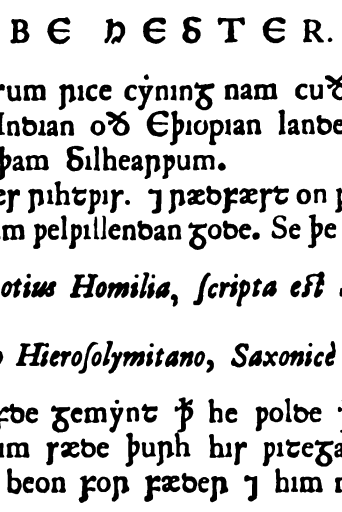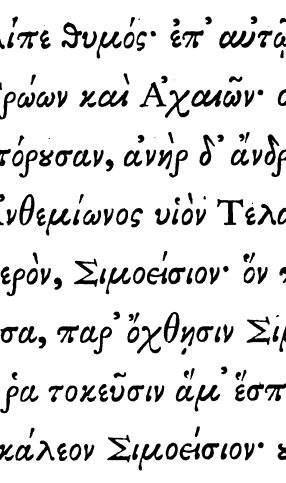Design and History of Junicode

The design of Junicode is based on scans of George Hickes, Linguarum vett. septentrionalium thesaurus grammatico-criticus et archaeologicus (Oxford: Sheldonian Theatre, 1703–5). This massive two-volume folio is a good example of the work of the Oxford University Press at this period: printed in multiple types (for every language had to have the type that was proper to it) and lavishly illustrated with engravings of manuscript pages, coins and artifacts. An excellent facsimile of volume two of this work, the famous (to medievalists) catalogue of manuscripts containing Anglo-Saxon by Humfrey Wanley, can be seen at the Hathi Trust.
The type used for Hickes’s Thesaurus may be one of those assembled by John Fell (1625–86) and bequeathed by him to the University of Oxford. To my eye, however, this type looks more like the “Pica Roman” purchased by the University in 1692 than like any of those bequeathed by John Fell. For printing in Old English (see right), this type was supplemented by the “Pica Saxon” commissioned by the early Anglo-Saxonist Franciscus Junius (1591–1677) and bequeathed to the University. Specimens of both can be found in A Specimen of the Several Sorts of Letter Given to the University by Dr. John Fell, Sometime Lord Bishop of Oxford. To Which Is Added the Letter Given by Mr. F. Junius. It seems likely that Junius’s Pica Saxon was mixed pretty freely with Pica Roman in printing the Thesaurus.
Junicode’s Greek face has a different origin from the Latin. Though the capitals are designed to harmonize with the Latin characters, the lowercase Greek is based on type designed by Alexander Wilson (1714–86) of Glasgow and used in numerous books published by the Foulis Press, most notably the great Glasgow Homer (see below right).
This Greek type is, obviously, not terribly useful for modern purposes: modern Greek typographical usage is very different indeed from that of eighteenth-century Scottish schoolbooks. But the Wilson type is very beautiful; and as there is no great shortage of Greek typefaces, it seems fair that at least a few fonts should cater to those who wish to reproduce the look of old printed books. Persons looking for good modern Greek typefaces should look over the wonderful offerings of the Greek Font Society, several of whose free typefaces harmonize well with Junicode.
Junicode added the Gothic range in version 0.7.4, and in 0.7.5 it was extended to all faces. The design is based on the Gothic font commissioned by Franciscus Junius and used in his editio princeps of the Gothic Bible. It has been adapted for accuracy and to harmonize with the rest of the Junicode font. The version in the bold face is closest to Junius’s original (see below).


History of Junicode

In the early 1990s I digitized the Pica Saxon from Hickes’s Thesaurus and released it under the name “Junius,” announcing it on the ANSAXNET mailing list and mailing 3.5" disks to interested scholars. Not that there was a whole lot of interest: Old English editions are no longer printed in “Saxon” type but rather transliterated into modern characters (except for the letters þ and ð, also used in modern Icelandic). In due time I added italic and bold versions of the typeface and a general-purpose version of the font. These are still around, and can be downloaded here, though they are now technologically backward, not having been updated since 1996.
Junicode (on which I began work around 1998) is based on these “Junius” fonts, with a greatly expanded Unicode character set and somewhat more modern proportions (capitals somewhat smaller and x-height a little bigger). Early work was done with the old Fontographer program. By 2003, after I had begun to use Linux for most purposes, I moved development to FontForge (then known as PfaEdit). In 2006 Junicode moved to its current home at Sourceforge.
Development of the font is ongoing (as time permits: this is not my day job). Long-term goals include completion of the MUFI character set and the Unicode phonetic ranges in all four faces.